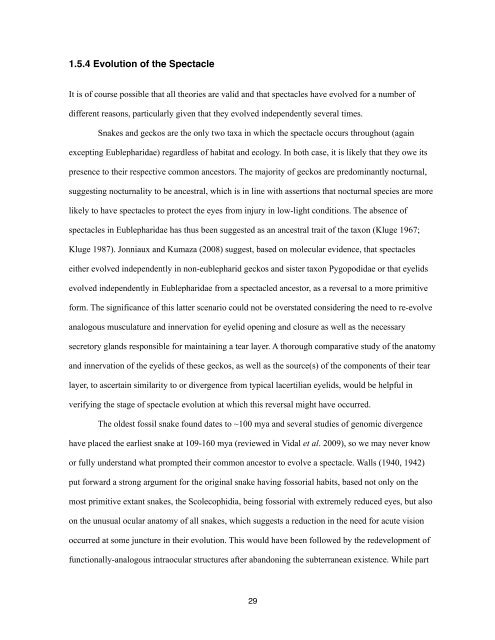Chapter 1, The Reptilian Spectacle - UWSpace - University of ...
Chapter 1, The Reptilian Spectacle - UWSpace - University of ...
Chapter 1, The Reptilian Spectacle - UWSpace - University of ...
Create successful ePaper yourself
Turn your PDF publications into a flip-book with our unique Google optimized e-Paper software.
1.5.4 Evolution <strong>of</strong> the <strong>Spectacle</strong><br />
It is <strong>of</strong> course possible that all theories are valid and that spectacles have evolved for a number <strong>of</strong><br />
different reasons, particularly given that they evolved independently several times.<br />
Snakes and geckos are the only two taxa in which the spectacle occurs throughout (again<br />
excepting Eublepharidae) regardless <strong>of</strong> habitat and ecology. In both case, it is likely that they owe its<br />
presence to their respective common ancestors. <strong>The</strong> majority <strong>of</strong> geckos are predominantly nocturnal,<br />
suggesting nocturnality to be ancestral, which is in line with assertions that nocturnal species are more<br />
likely to have spectacles to protect the eyes from injury in low-light conditions. <strong>The</strong> absence <strong>of</strong><br />
spectacles in Eublepharidae has thus been suggested as an ancestral trait <strong>of</strong> the taxon (Kluge 1967;<br />
Kluge 1987). Jonniaux and Kumaza (2008) suggest, based on molecular evidence, that spectacles<br />
either evolved independently in non-eublepharid geckos and sister taxon Pygopodidae or that eyelids<br />
evolved independently in Eublepharidae from a spectacled ancestor, as a reversal to a more primitive<br />
form. <strong>The</strong> significance <strong>of</strong> this latter scenario could not be overstated considering the need to re-evolve<br />
analogous musculature and innervation for eyelid opening and closure as well as the necessary<br />
secretory glands responsible for maintaining a tear layer. A thorough comparative study <strong>of</strong> the anatomy<br />
and innervation <strong>of</strong> the eyelids <strong>of</strong> these geckos, as well as the source(s) <strong>of</strong> the components <strong>of</strong> their tear<br />
layer, to ascertain similarity to or divergence from typical lacertilian eyelids, would be helpful in<br />
verifying the stage <strong>of</strong> spectacle evolution at which this reversal might have occurred.<br />
<strong>The</strong> oldest fossil snake found dates to ~100 mya and several studies <strong>of</strong> genomic divergence<br />
have placed the earliest snake at 109-160 mya (reviewed in Vidal et al. 2009), so we may never know<br />
or fully understand what prompted their common ancestor to evolve a spectacle. Walls (1940, 1942)<br />
put forward a strong argument for the original snake having fossorial habits, based not only on the<br />
most primitive extant snakes, the Scolecophidia, being fossorial with extremely reduced eyes, but also<br />
on the unusual ocular anatomy <strong>of</strong> all snakes, which suggests a reduction in the need for acute vision<br />
occurred at some juncture in their evolution. This would have been followed by the redevelopment <strong>of</strong><br />
functionally-analogous intraocular structures after abandoning the subterranean existence. While part<br />
29
















